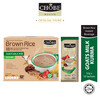
Understanding the Glycemic Index: A Key to Balancing Blood Sugar Levels and Promoting Overall Health
Are you tired of the constant spikes and crashes in your energy levels throughout the day?
Do you want to take control of your blood sugar levels and promote overall health?
Look no further than understanding the glycemic index. The glycemic index is a powerful tool that helps you make informed choices about the foods you eat, enabling you to maintain stable blood sugar levels and optimize your well-being. In this article, we will dive deep into the world of the glycemic index, exploring what it is, how it works, and why it is essential for maintaining a balanced diet. Whether you are a health-conscious individual or someone looking to improve their energy levels, this information is for you. Join us as we unravel the secrets of the glycemic index and unlock the key to a healthier, more vibrant life.
What is blood sugar and why is it important?
Before we delve into the intricacies of the glycemic index, let's first understand what blood sugar is and why it plays a crucial role in our overall health. Blood sugar, scientifically known as glucose, is the primary source of energy for our bodies. It is derived from the carbohydrates we consume and is transported through the bloodstream to our cells, where it is used for various bodily functions. Maintaining stable blood sugar levels is essential because it ensures that our cells receive a constant supply of energy, allowing our bodies to function optimally.
However, when our blood sugar levels become imbalanced, it can lead to a host of health issues. High blood sugar levels, also known as hyperglycemia, can result in fatigue, increased thirst, frequent urination, and even long-term complications such as diabetes. On the other hand, low blood sugar levels, known as hypoglycemia, can cause dizziness, confusion, and weakness. Therefore, understanding how to balance blood sugar levels is crucial for our overall well-being.
The basics of the glycemic index
Now that we have a basic understanding of blood sugar and its importance, let's explore the glycemic index. The glycemic index (GI) is a ranking system that measures how quickly carbohydrates in food raise blood sugar levels compared to pure glucose, which has a GI value of 100. Foods with a high GI value are quickly digested and absorbed, resulting in a rapid increase in blood sugar levels. Conversely, foods with a low-glycemic index (low GI) value are digested and absorbed more slowly, leading to a gradual and steady rise in blood sugar levels.
The glycemic index is measured on a scale of 0 to 100, with the following classifications:
- Low GI: 55 or less
- Medium GI: 56-69
- High GI: 70 or higher
GI of a food can be influenced by factors such as ripeness, processing, cooking methods, and the presence of other macronutrients in a meal. Combining low-glycemic index (low GI) foods with protein, healthy fats, and fiber can help stabilize blood sugar levels and provide sustained energy throughout the day.
Low GI Foods (GI 0-55):
Legumes: Chickpeas, lentils, kidney beans, black beans.
Whole Grains: Barley, brown rice, quinoa, whole wheat, steel-cut oats.
Fruits: Cherries, apples, pears, grapefruit, oranges, plums, peaches.
Non-starchy Vegetables: Broccoli, cauliflower, leafy greens, tomatoes, cucumbers.
Dairy: Whole milk, yogurt (without added sugars).
Nuts: Peanuts, cashews, almonds.
Medium GI Foods (GI 56-69):
Fruits: Pineapple, mango, banana, kiwi, grapes.
Whole Grains: Basmati rice, couscous, rye bread.
Starchy Vegetables: Sweet potatoes, new potatoes, corn.
Legumes: Black-eyed peas, baked beans.
High GI Foods (GI 70 and above):
White Bread: Baguette, white sandwich bread.
White Rice: Short-grain, long-grain white rice.
Breakfast Cereals: Corn flakes, Rice Krispies, most sugary cereals.
Sweets: Sugary snacks, candy, doughnuts, cakes.
Potatoes: Mashed potatoes, instant potatoes, potato chips.
Beverages: Soft drinks, energy drinks, sports drinks.
By understanding the GI value of various foods, we can make informed choices about what we eat and how it will impact our blood sugar levels. This knowledge is particularly crucial for individuals with conditions such as diabetes, where maintaining stable blood sugar levels is of utmost importance.
How the glycemic index affects blood sugar levels
Now that we have a basic understanding of the glycemic index, let's explore how it affects blood sugar levels. When we consume high GI foods, such as white bread, sugary beverages, or processed snacks, our blood sugar levels spike rapidly. This sudden increase triggers a surge of insulin, a hormone produced by the pancreas that helps regulate blood sugar levels. Insulin helps transport glucose from the bloodstream into our cells, where it can be utilized for energy or stored for later use.
However, the rapid rise in blood sugar levels caused by high GI foods can lead to an overproduction of insulin. This can result in a subsequent drop in blood sugar levels, leaving us feeling fatigued, hungry, and craving more high GI foods to restore our energy levels. This vicious cycle of spikes and crashes can take a toll on our overall health and make it challenging to maintain stable blood sugar levels.
On the other hand, consuming low-glycemic index (low GI) foods, such as whole grains, fruits, and vegetables, leads to a gradual and steady increase in blood sugar levels. This slower digestion and absorption process allow for a more controlled release of energy and a more stable blood sugar profile. By incorporating more low-glycemic index (low GI) foods into our diet, we can avoid the energy rollercoaster and maintain consistent energy levels throughout the day.
The impact of high glycemic foods on health
The consumption of high GI foods has been linked to a range of health issues. One of the most significant concerns is the increased risk of developing type 2 diabetes. When we regularly consume high GI foods, our bodies become less efficient at producing insulin, leading to insulin resistance. Insulin resistance is a condition where our cells become less responsive to the effects of insulin, resulting in elevated blood sugar levels. Over time, this can lead to the development of type 2 diabetes.
Additionally, a diet high in high GI foods has been associated with weight gain and obesity. The rapid rise in blood sugar levels caused by these foods triggers the release of insulin, which promotes fat storage. Furthermore, the frequent spikes and crashes in blood sugar levels can lead to increased hunger and cravings, making it difficult to maintain a healthy weight.
Apart from these metabolic effects, a diet rich in high GI foods has also been linked to an increased risk of heart disease, certain types of cancer, and even mental health issues such as depression and anxiety. Therefore, understanding the impact of high GI foods on our health is crucial for making informed choices about our diet.
Low glycemic foods and their benefits
Now that we understand the negative impact of high GI foods, let's explore the benefits of incorporating more low-glycemic index (low GI) foods into our diet. Low-glycemic index (low GI) foods are digested and absorbed more slowly, leading to a gradual and steady rise in blood sugar levels. This controlled release of energy provides several benefits for our overall health.
One of the significant advantages of consuming low-glycemic index (low GI) foods is improved energy levels. Unlike high GI foods that cause spikes and crashes, low-glycemic index (low GI) foods provide a sustained release of energy, allowing us to maintain consistent energy levels throughout the day. This can be particularly beneficial for athletes or individuals with physically demanding lifestyles.
In addition to stable energy levels, low-glycemic index (low GI) foods can help promote satiety and aid in weight management. The slow digestion and absorption of these foods keep us feeling fuller for longer, reducing the likelihood of overeating or snacking on unhealthy foods. This can be especially beneficial for individuals looking to lose weight or maintain a healthy weight.
Moreover, a diet rich in low-glycemic index (low GI) foods has been associated with better blood sugar control, reduced risk of heart disease, improved insulin sensitivity, and even a lower incidence of certain types of cancer. These health benefits make low-glycemic index (low GI) foods an essential component of a balanced diet.
Using the glycemic index for weight management
If you're looking to manage your weight effectively, the glycemic index can be a valuable tool. By choosing low-glycemic index (low GI) foods, you can maintain stable blood sugar levels, avoid energy crashes, and reduce cravings for unhealthy snacks. Incorporating low-glycemic index (low GI) foods into your diet can help you feel satisfied and full for longer periods, making it easier to adhere to a healthy eating plan.
When planning your meals, opt for whole grains, legumes, fruits, and vegetables, which tend to have lower GI values. These foods provide essential nutrients, fiber, and antioxidants, promoting overall health while helping you achieve your weight management goals.
It's important to note that the glycemic index is just one aspect of a healthy diet. Portion control, balanced macronutrient intake, and overall calorie balance also play vital roles in weight management. By combining these principles with the glycemic index, you can create a well-rounded approach to achieving your weight-related objectives.
Incorporating low glycemic foods into your diet
Now that we understand the benefits of low-glycemic index (low GI) foods, let's explore some practical ways to incorporate them into our diet. Here are a few tips to get you started:
1. Choose whole grains: Opt for whole grain bread, brown rice, quinoa, and oats instead of refined grains. These whole grains have a lower GI value and provide more fiber, vitamins, and minerals.
2. Include plenty of fruits and vegetables: Fruits and vegetables are naturally low in GI and high in fiber, making them excellent choices for maintaining stable blood sugar levels. Aim to include a variety of colorful produce in your meals.
3. Don't forget the legumes: Beans, lentils, and chickpeas are not only rich in fiber and protein but also have a low-glycemic index (low GI) value. Incorporate them into soups, salads, or main dishes for added nutritional benefits.
4. Pair carbohydrates with protein and healthy fats: Combining carbohydrates with protein and healthy fats can further lower the overall GI of a meal. For example, have a handful of nuts or a dollop of Greek yogurt with your fruit.
5. Limit processed and sugary foods: Processed foods, sugary snacks, and beverages tend to have high GI values and offer little nutritional value. Minimize their consumption and opt for healthier alternatives.
By making these simple adjustments to your diet, you can enjoy the benefits of low-glycemic index (low GI) foods and maintain stable blood sugar levels throughout the day.
Tips for maintaining balanced blood sugar levels
Apart from incorporating low-glycemic index (low GI) foods into your diet, there are several other tips you can follow to maintain balanced blood sugar levels. Here are a few:
1. Eat regular meals: Consistency is key when it comes to stabilizing blood sugar levels. Aim to eat balanced meals at regular intervals throughout the day, rather than relying on large, infrequent meals.
2. Avoid skipping breakfast: Breakfast kickstarts your metabolism and provides energy for the day ahead. Include a combination of low-glycemic index (low GI) carbohydrates, lean protein, and healthy fats in your morning meal.
3. Stay hydrated: Drinking enough water is essential for maintaining optimal blood sugar levels. Aim to consume at least eight glasses of water per day and limit sugary beverages.
4. Engage in regular physical activity: Exercise helps improve insulin sensitivity and can aid in stabilizing blood sugar levels. Aim for at least 30 minutes of moderate-intensity exercise most days of the week.
5. Manage stress levels: Chronic stress can lead to imbalances in blood sugar levels. Incorporate stress management techniques such as meditation, deep breathing exercises, or engaging in hobbies you enjoy.
By implementing these tips into your daily routine, you can support balanced blood sugar levels and promote overall health.
The role of the glycemic index in managing diabetes
For individuals with diabetes, understanding and managing blood sugar levels is of utmost importance. The glycemic index plays a critical role in diabetes management by helping individuals make informed choices about the foods they consume.
For individuals with type 1 diabetes, who rely on insulin injections for blood sugar control, the glycemic index can be a valuable tool. By choosing low-glycemic index (low GI) foods, they can better predict how their blood sugar levels will respond to certain foods and adjust their insulin doses accordingly. This can help prevent dangerous spikes or drops in blood sugar levels.
For individuals with type 2 diabetes, who often struggle with insulin resistance, the glycemic index can aid in blood sugar control and weight management. By selecting low-glycemic index (low GI) foods and incorporating them into a well-balanced diet, individuals with type 2 diabetes can achieve more stable blood sugar levels, reduce the reliance on medication, and improve overall health.
However, it's essential to note that the glycemic index is not the sole determining factor for managing diabetes. Portion control, overall calorie intake, and regular monitoring of blood sugar levels are equally important. It's crucial for individuals with diabetes to work closely with their healthcare team to develop a comprehensive management plan that suits their specific needs.
Does Brown Rice consider as low-glycemic index (low GI)
Yes, brown rice is considered a low glycemic index (GI) food. The glycemic index is a scale that measures how quickly carbohydrates in foods raise blood sugar levels. Foods with a low-glycemic index (low GI) (55 or less) are digested and absorbed more slowly, resulting in a gradual increase in blood sugar levels.
Brown rice has a lower GI compared to white rice because it retains its outer bran layer, which contains fiber and nutrients. The bran layer slows down the digestion and absorption of carbohydrates, leading to a more stable and slower increase in blood sugar levels. In contrast, white rice is processed and has the bran layer removed, which increases its GI and causes a quicker spike in blood sugar.
As a result of its low-glycemic index (low GI), brown rice is often recommended for individuals who want to manage their blood sugar levels, control diabetes, or maintain a more consistent energy level throughout the day. It also provides more nutritional value compared to white rice due to the retained bran layer, making it a healthier option for many people.
Conclusion
Understanding the glycemic index is a powerful tool for balancing blood sugar levels and promoting overall health. By choosing low-glycemic index (low GI) foods, we can avoid the energy crashes and imbalances associated with high GI foods. Incorporating low-glycemic index (low GI) foods into our diet provides numerous benefits, including stable energy levels, improved weight management, and reduced risk of chronic diseases.
Whether you're a health-conscious individual or someone looking to optimize your energy levels, incorporating the principles of the glycemic index into your diet can make a significant impact on your overall well-being. By making informed choices about the foods you eat and following the tips provided, you can take control of your blood sugar levels and unlock the key to a healthier, more vibrant life.
Remember, the glycemic index is just one piece of the puzzle when it comes to maintaining a balanced diet. It's essential to prioritize overall nutrition, portion control, and a variety of food choices for optimal health.
Chobe instant brown rice drink original (unsweetened), which is known to have a low glycemic index (low GI). are generally recommended for promoting stable blood sugar levels and overall health.
https://www.premiercereal.com/collections/chobe-master/products/chobe-master-ori








